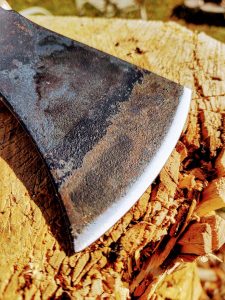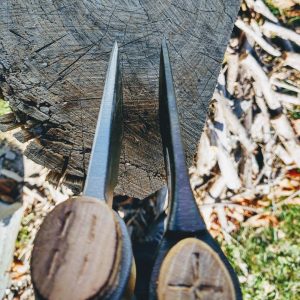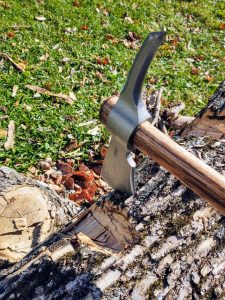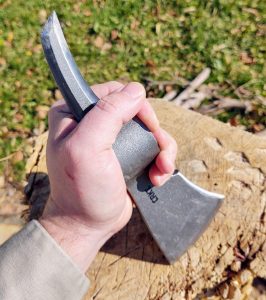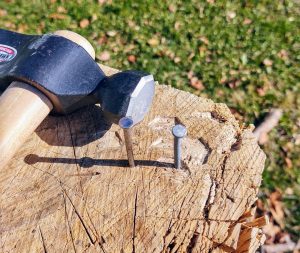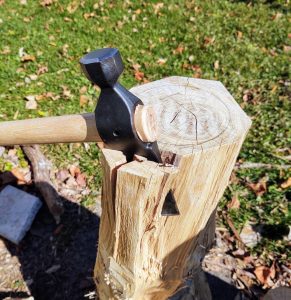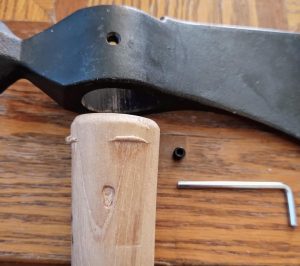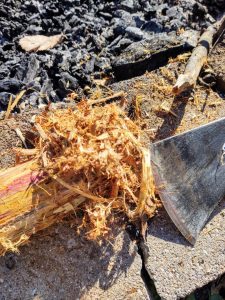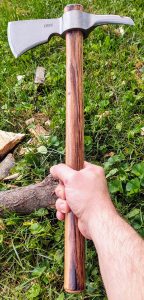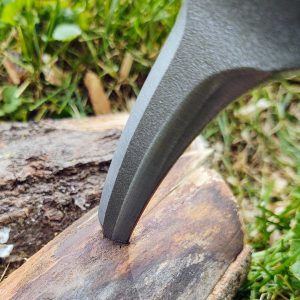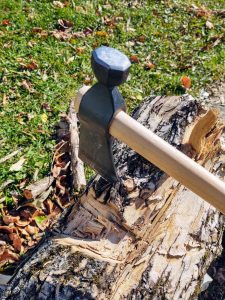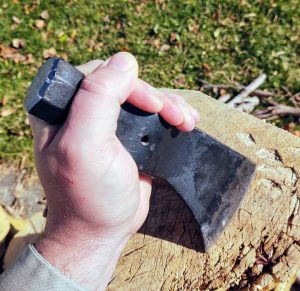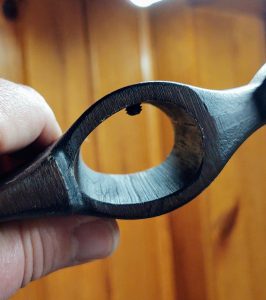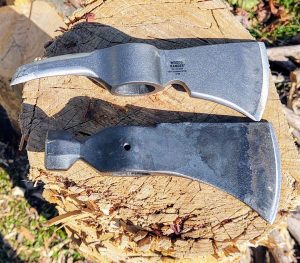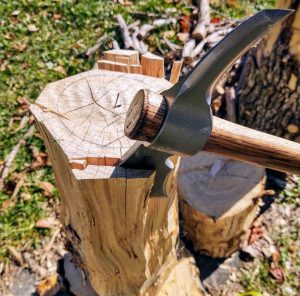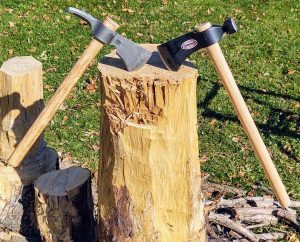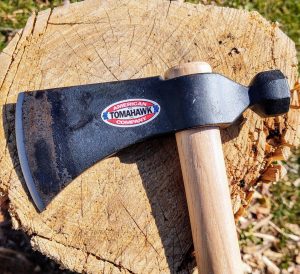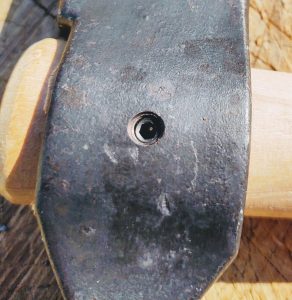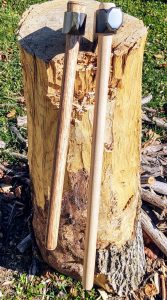Tomahawks were and are still sought after as a lightweight multipurpose outdoor tool.
Their small size makes them ideal for being carried in the hand, on a beltline, or attached to a pack.
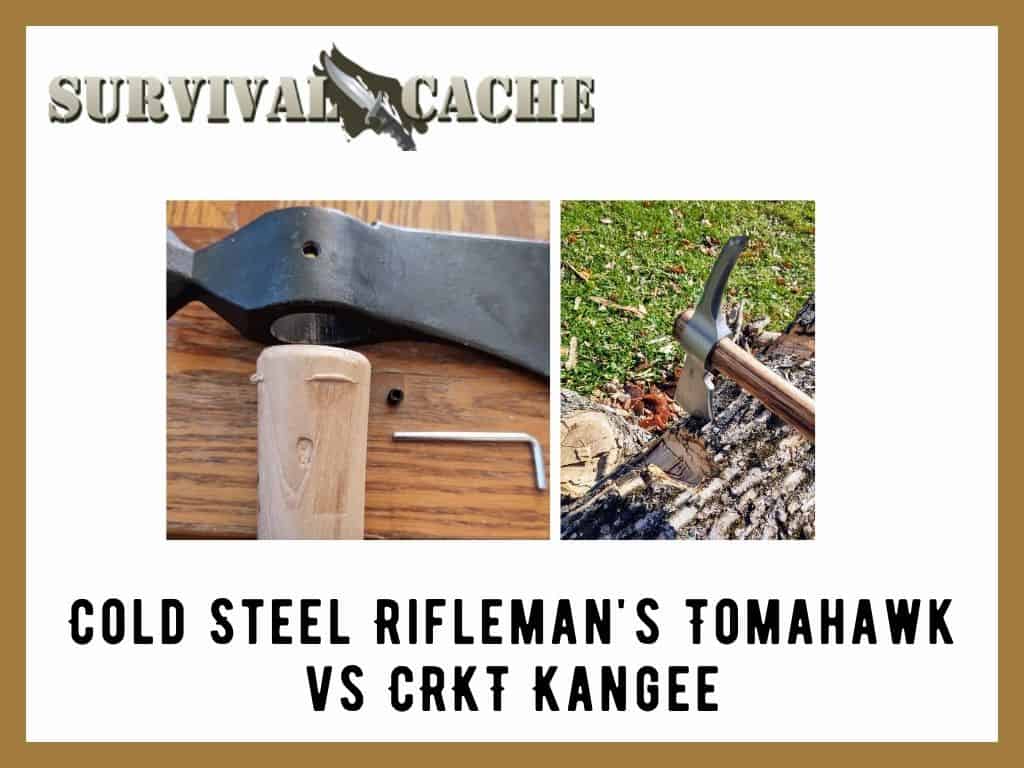
They work well for chopping, digging, processing game, processing wood, hammering, scraping, can be thrown, and work well as a personal weapon.
In this article I will compare two tomahawks from two well-known knife companies: the Rifleman’s Tomahawk by Cold Steel vs. the Kangee by CRKT.
Does one of the hawks stand above the other? Let’s find out together by first taking a look at the Rifleman’s Tomahawk.
SKIP AHEAD
Cold Steel Rifleman’s Tomahawk Specifications
Material
The head of the tomahawk is made from 5150 carbon steel
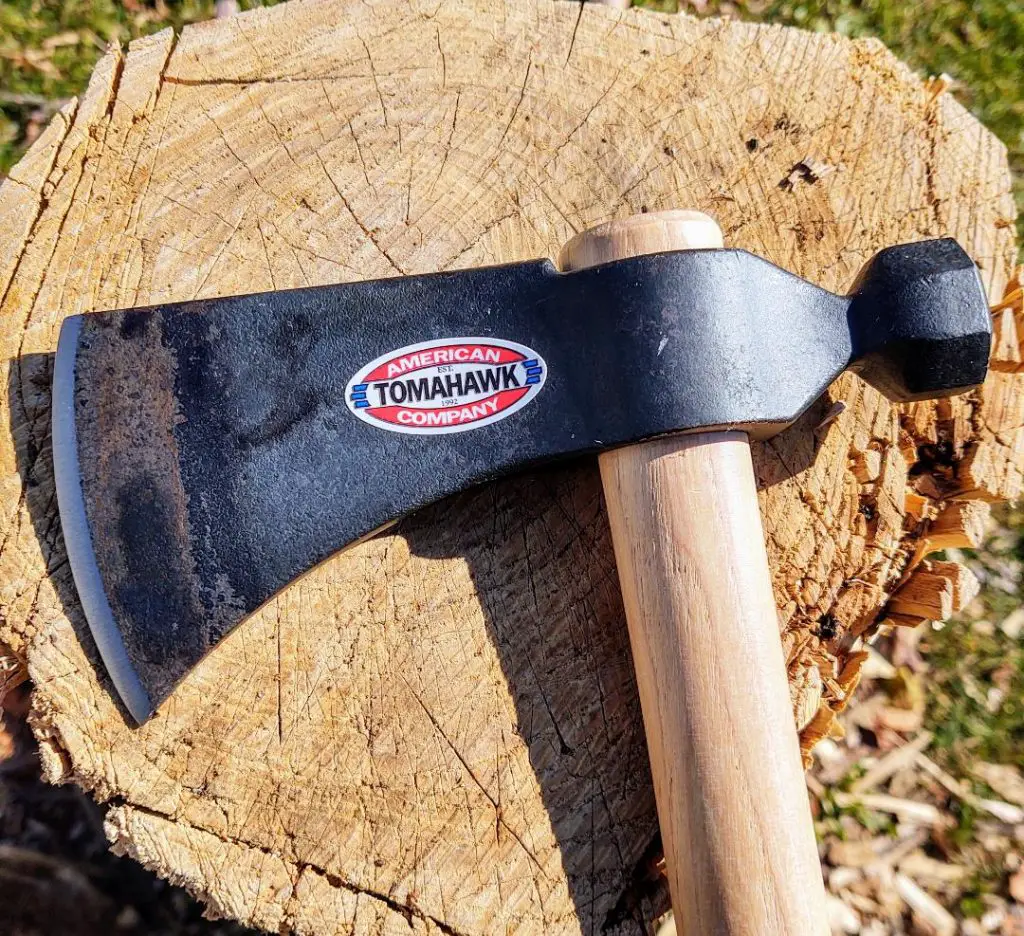
Dimensions
The cutting edge is 3 ½” and with a hammerhead on the back.
The American Hickory handle is 22” long
Weight
The Rifleman weighs in at 1lb 10oz.
First Impression
Upon unboxing this tomahawk there is a sticker right across the metal head that says, “American Tomahawk Company.”
I feel that I need to address this because it has drawn many complaints from customers who do not think they are getting a Cold Steel product.
Part of the confusion lies in that there is another company called “American Tomahawk Company.”
These two companies are not affiliated with one another, and the American Tomahawk Company sticker is used by Cold Steel on their tomahawks.
The Finish
I have been a Cold Steel customer for years and I have been very happy with every purchase I have made. Having said that, I cannot believe what arrived in the mail.
To be fair, I did not purchase the Rifleman directly from Cold Steel but a dealer.
I am all for chopping heads that have some character to them after years of use but when I pulled the Rifleman’s Tomahawk from the box I couldn’t believe I was holding a Cold Steel product.
The metal head was heavily pitted and scratched, the finish was coming off and peeling, the cutting edge was dull and there was surface rust throughout the head!
These are primarily aesthetic issues that did not have any effect on the operation of the tomahawk, but I still felt like I needed to address this nonetheless.
During normal times I would have sent this back but given that shipping times nowadays are anyone’s guess, I decided to keep the tomahawk and fix these issues myself.
Testing It Out
With all products that I test, I do so as they come right out of the box. The Rifleman needed to be sharpened but I decided to leave it as is, at least initially.
Weight
At 1lb 10oz it is not heavy in the hands but has enough weight behind it to get some serious work done.
Not being overly heavy allows for this tool to be easily carried on the beltline or a pack.
Handle
The straight Hickory handle feels great in the hand. I am happy that there is not a thick lacquer finish on it like there is on the Kangee. This helped to keep a firm grip on the handle when in use.
The 22” handle is just the right length that allowed me to use this hawk both one and two-handed. Being able to comfortably use two hands makes chopping tasks much more effective.
Chopping
I started out chopping through small diameter limbs and moved my way up to roughly one half inch diameter pieces.
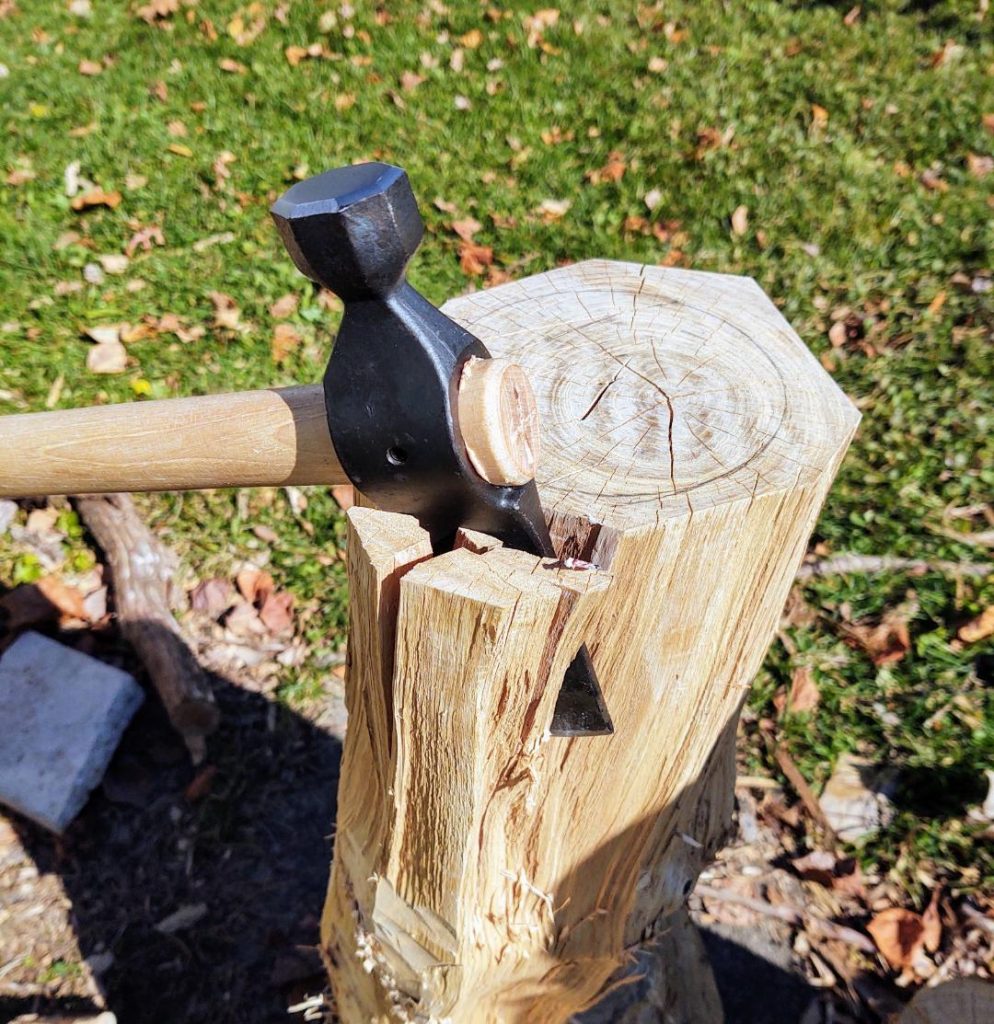
The hawk handled these well and I was able to get through all of the pieces in one swing.
I moved on to a piece of Cedar that was roughly three inches in diameter. It was here that I started to notice the blade bouncing off the wood more than digging into it.
Part of this had to do with the cutting edge being rather dull right out of the box.
Regardless, I was able to get through the wood and process the limb with minimal effort.
Lastly, I decided to start swinging at some bigger logs. The log in front of me was roughly ten inches in diameter and I had no intention of chopping all of the ways through it.
I took ten full swings and produced a nice V cut. The blade bit into the wood well but not enough that it became stuck with every swing.
The few times the blade did become stuck in the wood, the 22” handle made it easier to remove.
This hawk is both highly enjoyable and comfortable to swing.
Hammering
The peace pipe design of the Rifleman offers a cutting edge on one side of the metal head and a flat head on the rear.
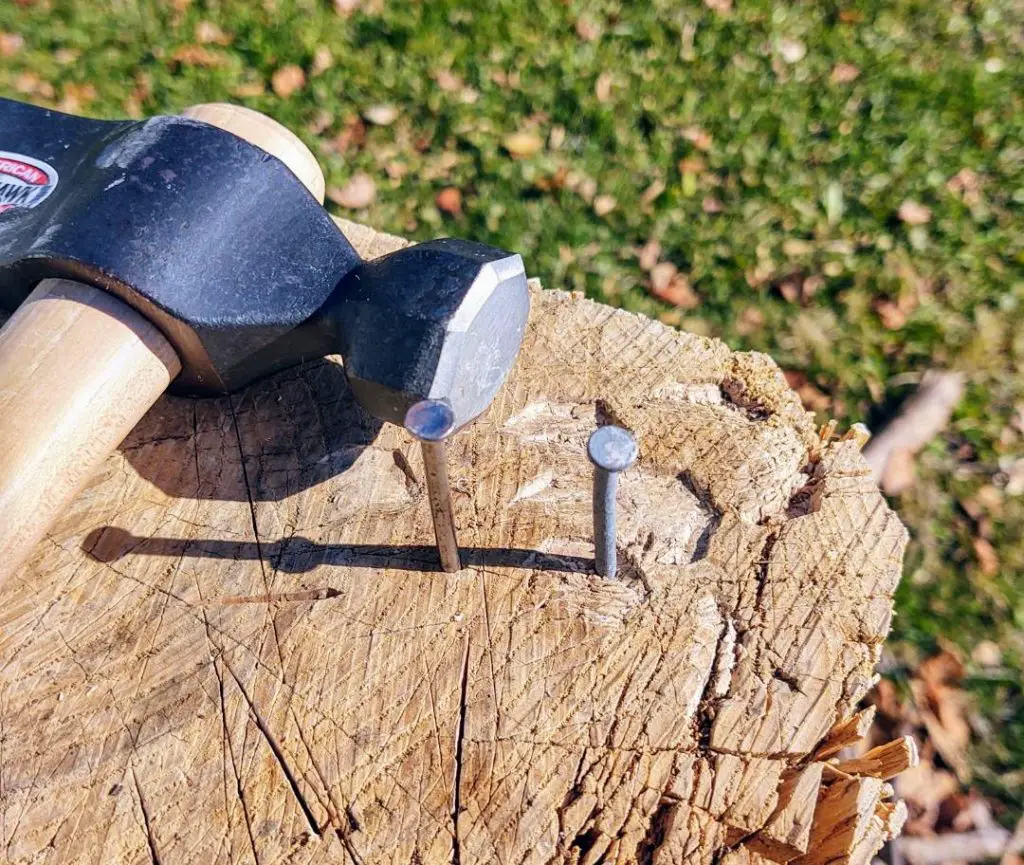
The flat head offers a good solid surface for hammering nails, stakes, and any other impact tasks a person could run into.
The hammer side of the head had no problem driving a couple of three-inch nails into the stump I use as a workbench or pounding stakes into the ground that were quickly made with the hawk.
Set Screw
I grabbed an allen wrench and removed the setscrew on the side of the head.
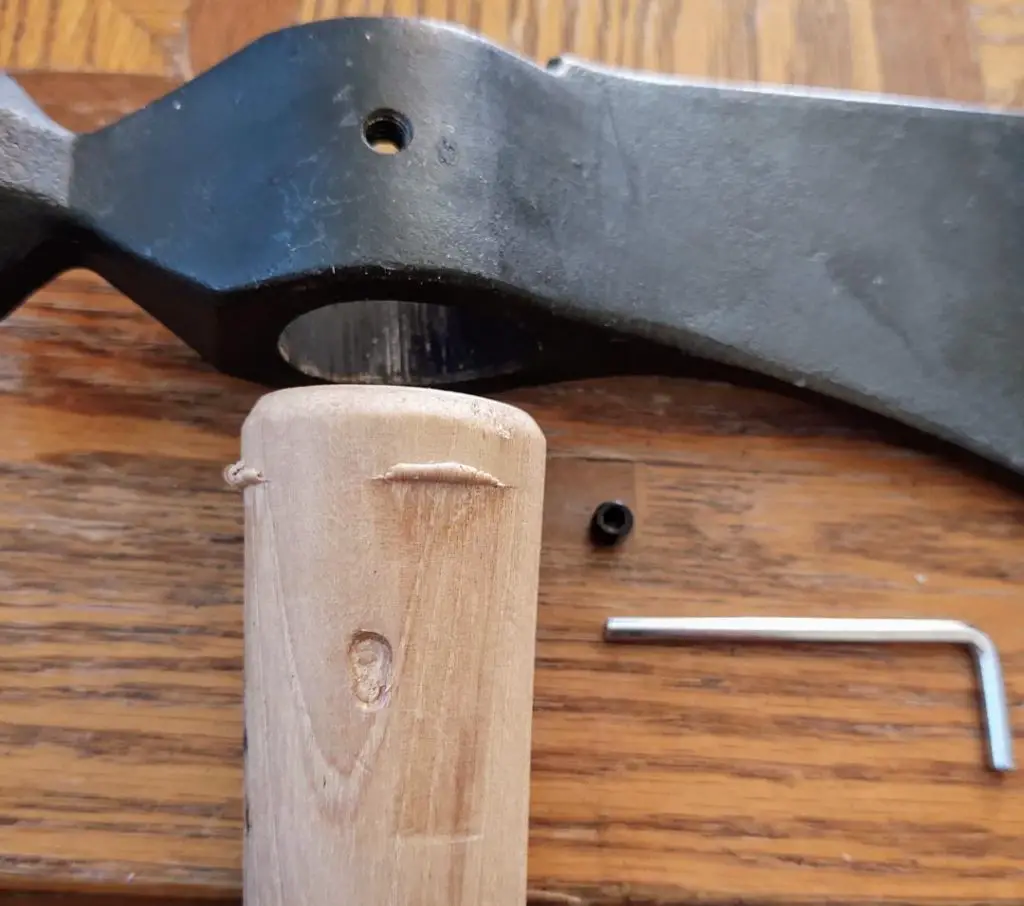
With the setscrew removed, the head easily slid down the handle. At the top of the handle where the head was situated, there was a decent sized hole in the wood from the screw digging into it.
When using the hawk, a lot of the force is going to be transferred to the screw which in turn will begin digging away at the wood. This damages the handle and will eventually cause the head to become loose.
If your intentions with the Rifleman are to use it as a showpiece then the setscrew can be left in place.
However, if you intend on using this tomahawk regularly outdoors then there are two reasons why I would recommend removing it.
The first is that it damages the handle as I mentioned above.
Secondly, I do not carry allen wrenches in my gear so I would not be able to make adjustments, and replacing a broken handle would be more difficult due to the screw.
After removing the screw, be sure to properly set the hawk head by inverting the handle and pounding it several times on a hard surface. Simply sliding the head to the end of the handle will not hold it in place.
Throwing
I am not much for throwing tomahawks though many people enjoy doing so.
I did not throw the Rifleman but all of the reviews I have seen, report that it throws exceptionally well and hits hard.
Scraping
Lastly, I wanted to get a fire going using nothing more than the Rifleman and a ferrocerium rod.
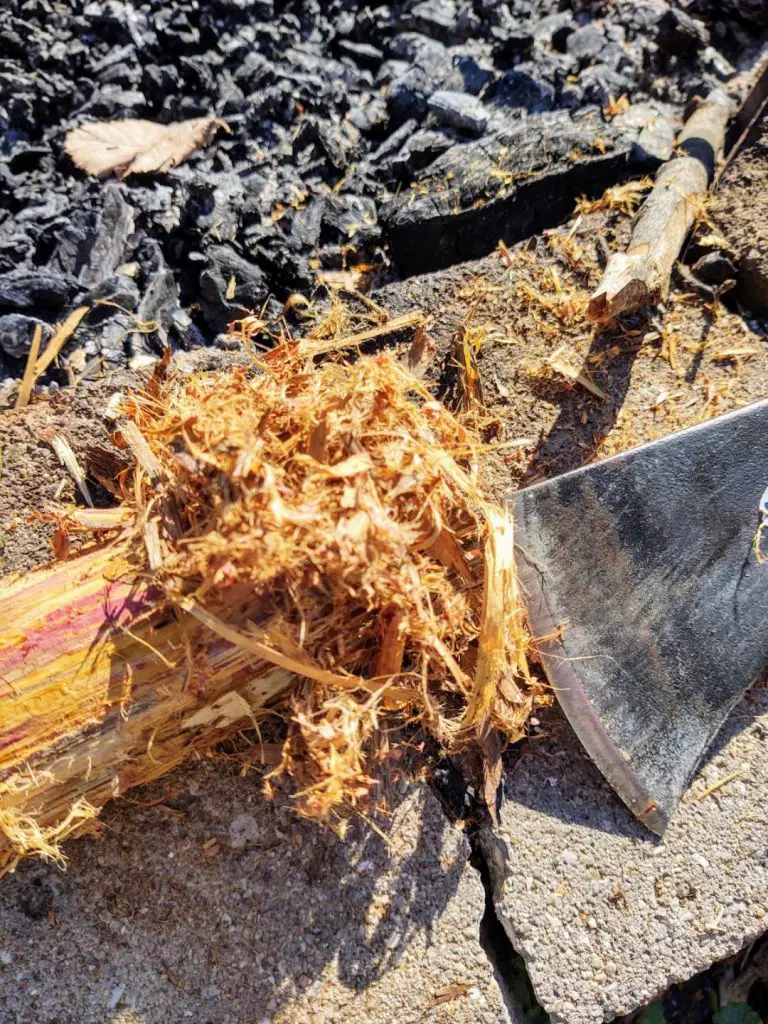
The head of the hawk fits comfortably in the hand and worked very well scraping a large tinder ball of cedar bark.
I placed the cedar bark under pieces of kindling I had chopped and by running the ferrocerium rod across the cutting edge I was able to easily produce a lot of sparks and get a fire going.
Sharpening
As I mentioned earlier, the head was rather dull upon arrival. After all the testing, I took it into the shop to fix the edge.
With a metal file, a sharpening stone, and about thirty minutes, I was able to make the cutting much sharper and honed its profile.
Cold Steel Rifleman Pros and Cons
Pros
- Well balanced
- Comfortable one-handed or two-handed use
- Without the setscrew, the head is easily removed to be used as a hand tool
- The backside of the head works great for impact tasks
Cons
- Setscrew damages the handle
- The cutting edge was dull, and the metal head arrived in poor condition
CRKT Kangee Tomahawk Specifications
Material
The Kangee head is made from 1055 carbon steel
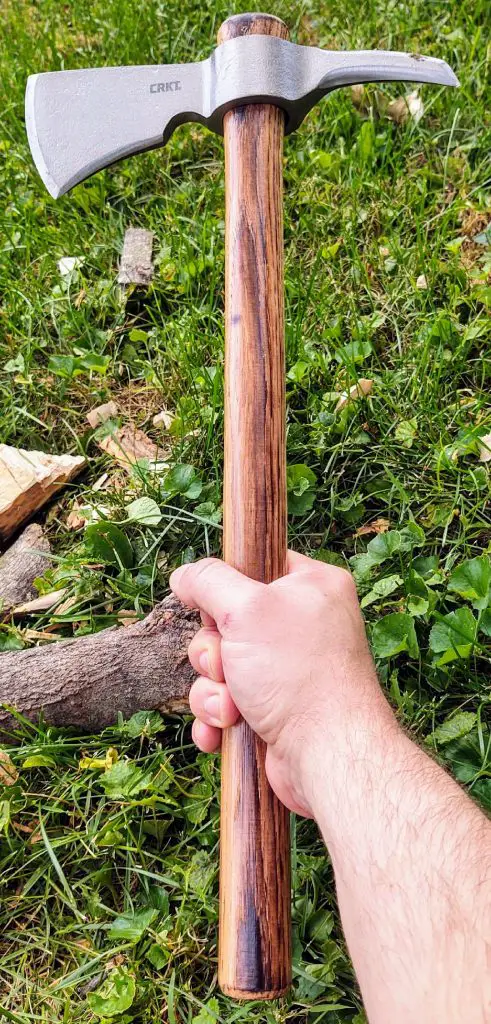
Dimensions
The length of the cutting edge is 4.21”
Handle
Made from Tennessee Hickory, the handle is 19.13” long and features a lacquer finish.
Weight
The Kangee weighs in at just 1lb 15oz.
First Impression
I have had the Kangee for a few months now and I have come to like it.
The first thing that I noticed was that the metal head was not smooth, nor did it have a mirror polish to it.
I do appreciate a mirror finish on some tools but ultimately it is not going to last if the tool is being used.
While I like the “rough” look to the head’s surface, some people may not which is the only reason I bring it up.
Testing It Out
Weight
The Kangee is slightly smaller and heavier than the Rifleman’s hawk but it is still very comfortable to hang on the beltline or on a pack.
It is well balanced in the hand and is comfortable to use with a low hold or choked grip high up on the handle.
Handle
Appearance-wise, the handle has a rich color to it and a smooth lacquer finish.
While the lacquer finish is appealing to the eye it does not provide a good grip, especially in sweating hands.
The 19” handle is great for one-handed use and can be used two-handed, but it is not as comfortable as the longer handle of The Rifleman.
The head slips on and off the handle easily and when pounded on, it holds exceptionally well with little movement during use.
Cutting Edge
The cutting edge was incredibly sharp out of the box and I was able to dry shave hairs from my arm.
After using the Kangee off and on for a few months it has retained its edge well and I have yet to sharpen it.
Chopping
I put the Kangee through the same chopping tests as the Rifleman above.
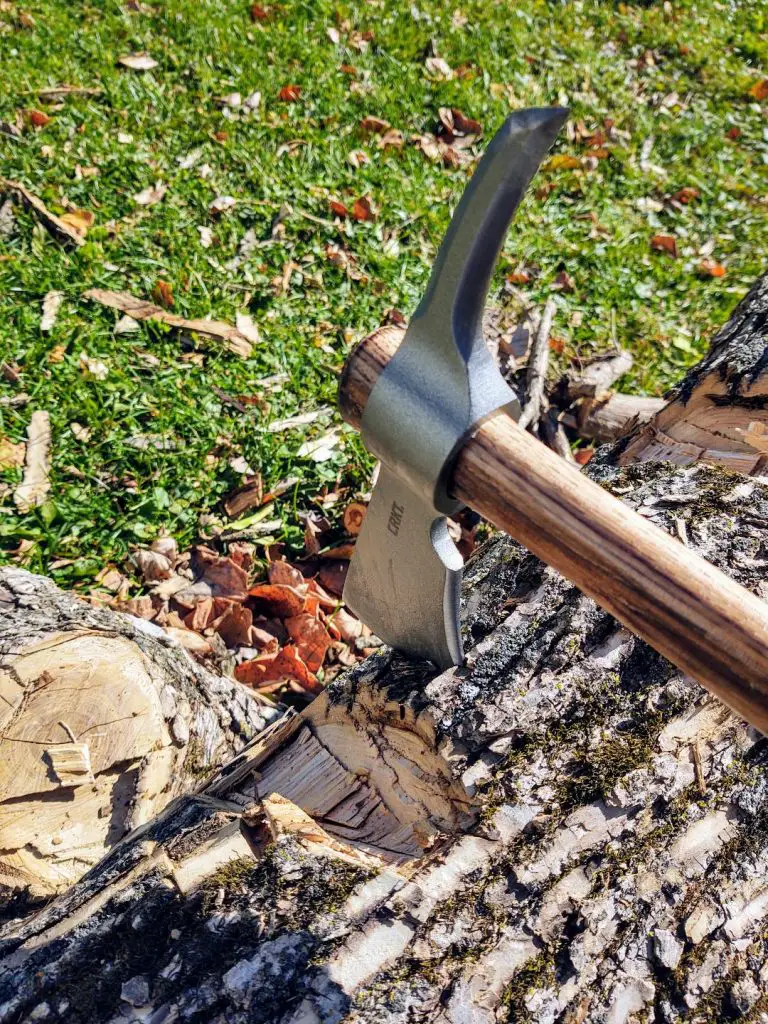
It did just fine chopping its way through limbs of various dimensions and the thicker cedar log.
When I moved up to the larger log and counted out ten swings, the cut was almost identical in depth to the Rifleman’s hawk.
Given that the profile of the Kangee head is slightly thicker I did not think it was going to stick in the wood as much as it did. But it was easily removed with a couple of pulls of the handle.
Spike
Opposite the cutting edge is a long spike that comes to a fine point with only the very last portion of it being sharped.
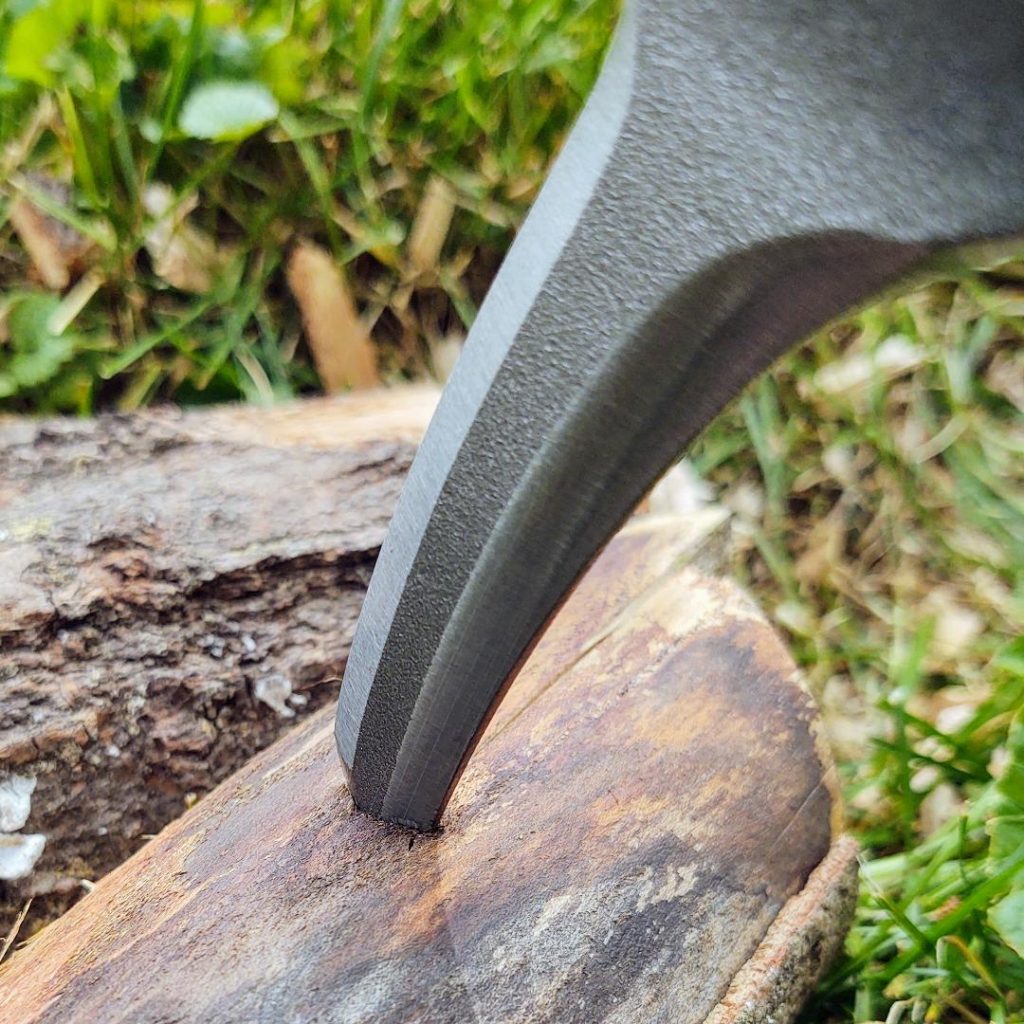
By flipping the hawk around, the spike works great for digging in soft soils and for other penetration tasks.
If you have never used a spiked tomahawk take your time using it as it can be a bit unnerving at first.
Hammering
The Kangee design is different than that of the peace pipe and it does not have a flat surface on the back for hammering.
Although it is not as effective, turning the Kangee sideways allows for the flat portion of the cutting head or the round section of the eye to be used when pounding stakes into the ground.
Scraping
The deep groove on the bottom of the head makes for an excellent grip when holding the head as a hand tool.
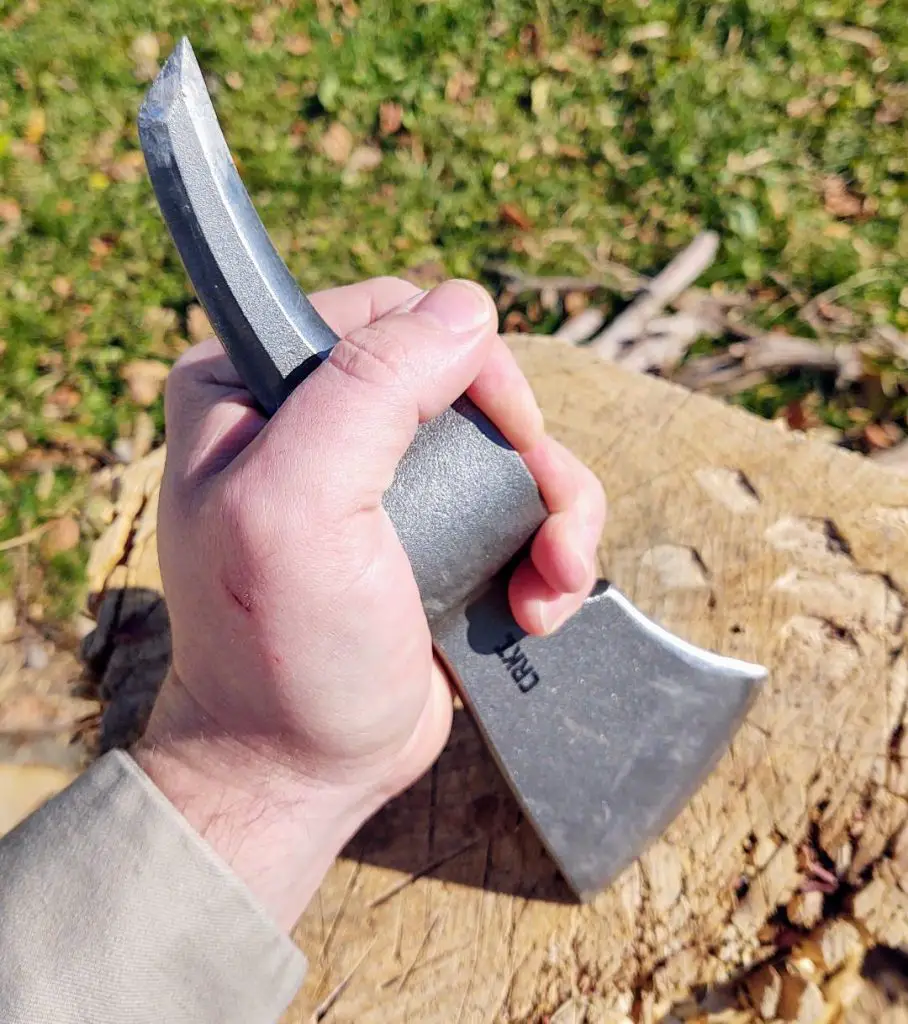
I used the head in this manner to scrape cedar bark as I did earlier and paired with a ferrocerium rod I was able to easily get a fire going.
Throwing
As with The Rifleman hawk, I did not throw the Kangee but people who do are happy with its performance.
The spike also allows for the Kangee to be thrown in two different orientations.
Sharpening
After a few months of use, the cutting edge was still in good working order but I decided to clean it up a little.
It only took me a few minutes with a sharpening stone to touch up the cutting edge and bring it back to perfection.
CRKT Kangee Tomahawk Pros and Cons
Pros
- Razor-sharp out of the box
- Chops extremely well
- The spike is a very efficient penetration tool
- The head is easily removed and replaced securely on the handle
Cons
- The lacquer finish becomes slick when hands are wet
- The handle was not a perfect fit for the head, daylight could be seen between the wood and the head
Rifleman Vs. Kangee at a Glance
Below is a table that quickly summarizes the specs between these two tools.
| Features | Rifleman’s Hawk | CRKT Kangee |
| Handle Material | American Hickory | Tennessee Hickory |
| Handle Length | 22” | 19.13” |
| Blade Length | 3.5” | 4.21” |
| Steel | 5150 Carbon Steel | 1055 Carbon Steel |
| Head Finish | Black | Silver |
| Handle Finish | Plain | Lacquer |
| Weight | 1lb 10oz | 1lb 15oz |
| Head Design | Hammer | Spike |
| Sheath | Not included | Not included |
FAQs
Q: Why are the chopping heads not permanently attached to the handles?
A: This is how tomahawks were traditionally made, with a pressure fit, allowing for the metal head to be easily removed and used as a hand tool. This also makes it much easier to replace a broken handle.
Q: Is there a way to permanently fix these tomahawk heads to the handles?
A: I’m pretty sure a similar procedure to hanging an ax handle could be used. However, it is more common to use leather, or the material of your choice, to wrap around the head and handle. This may not be a “permanent” fix but it will certainly keep the head secure if you do not wish to use it as a hand tool.
Q: Can tomahawks be thrown?
A: Tomahawks are great multitools. They can be used for chopping, scraping, digging, processing game and their compact size does makes them excellent for throwing!
However, be prepared that this activity requires a lot of practice and has the potential for damaging the handle.
Verdict
Since these two hawks are not the same design and both did well in my testing, I cannot state that one is better than the other. But I can offer you this.
The Cold Steel Rifleman is quite a bit cheaper than the Kangee. In fact, when I ordered the Rifleman it was about half of the cost of the Kangee.
If you are looking for an affordable, plain-looking hawk and you anticipate doing a lot of hammering, then I would suggest the Rifleman’s Tomahawk.
However, if you can spend a little more money, desire a more finished looking handle, and require a tool that is capable of penetrating tasks I would suggest going with the CRKT Kangee.
Thanks for reading and stay sharp!
Do you have any experience with either of the tomahawks featured in this article? Sound off in the comment section below and let us know what you think!


